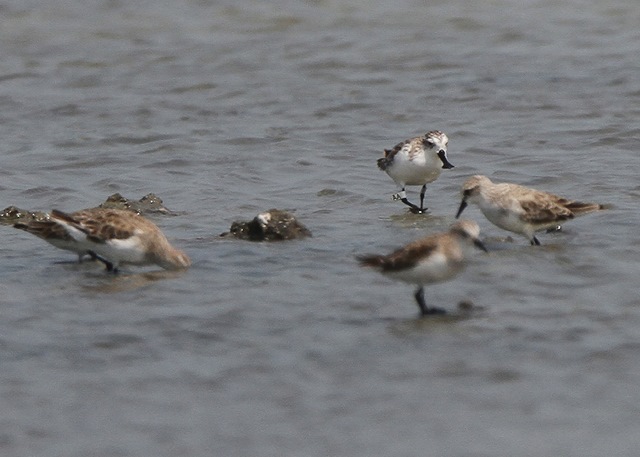Author: Philip D. Round
Report by Bird Conservation Society of Thailand
The following is a round-up of the Winter events from the Bird Conservation Society of Thailand:
“This was an eventful winter in the precarious history of the declining population of Spoon-billed Sandpipers. An International Workshop, hosted by BCST, was held at the Ban Khung Nam Resort in Samut Sakhon in early October, when Rob Sheldon of RSPB, and representatives from various countries hosting Spoon-billed Sandpipers either on passage or in winter reported on the situation of the species in flyway countries. We learned that as many as 140 Spoon-billed Sandpipers, a large proportion of the world population, were counted more or less simultaneously on the coast at Rudong, E China in the autumn. We also learned about head-starting in which clutches of eggs are taken by biologists on the NE Russian breeding grounds, the chicks hatched under an incubator, and then reared naturally in enclosures in their coastal tundra habitat, where they are protected from predators, until they are ready to migrate in their own time, as they would do naturally, adult birds having already left. Head-starting should help boost production of young through reducing predation losses. Additionally at least some of the pairs who have had their first clutches taken for head-starting, will go on to lay second clutches. Mathematical modeling shows that if head starting is continued for about seven years, in tandem with effective suppression of hunting by local fowlers in China, Myanmar and Bangladesh, where shorebird trappers are most active, the decline should be halted and the population should start to increase.
We learned that adults trapped on nests were fitted with numbered light green flags, and the head-started juveniles with numbered white flags. Following the meeting our own Suchart Daengphayon (Mr Tii) was the first off the mark, observing a white-flagged juvenile at Samut Maneerat, Samut Sakhon on 7 November. He was not able to photograph the bird or approach it closely, but he saw that one of the letters was the letter A. Presumably the same white-flagged bird was then seen at Khok Kham on 9 November by a group from Lanna Bird and Nature Conservation Club on their way to the bird fair, but they did not get the number. This bird was not seen again until 17 February when a visiting birder, Mike Buckland, photographed what was presumably the same individual at Pak Thale . The white-flag bore the letters AA indicating that it was a clutch collected from Meinypylgino, Chuchotka, NE Russia on 25 June 2014, which hatched on 5 July, was head-started on 25 July and was last seen in the breeding area on 6 August. This juvenile remained at Pak Thale until at least 14 March. This is an important sighting since it indicates that head-started Spoon-billed Sandpipers migrate normally.
In addition to the head-started juvenile, two green flagged adults were seen during the winter. Flag no 05 was found by Suchart at Khok Kham on 30 November and remained until at least 30 March when beginning to moult into breeding dress. A second adult, light green flag 02 appeared at Laem Phak Bia on 18 Decenber and seen on a single day. Both these adults were females, trapped at the nest, and were parents of head-started chicks.
An output of the October workshop was the agreement to conduct a coordinated Spoon-billed Sandpiper survey throughout wintering areas in mid-December. In Thailand this was implemented by BCST and collaborators. During the count period, a total of nine Spoon-billed Sandpipers were found in the Inner Gulf: two at Khlong Tamru in Chonburi, two at Khok Kham, two at Pak Thale and probably three at Laem Phak Bia. Both green-flagged birds feature in this total, but the white-flagged juvenile did not. This means there is clear evidence that at least 10 Spoon-billed Sandpipers occurred in the Inner Gulf of Thailand this winter.
A number of other sites which had either supported Spoon-billed Sandpipers in the past, or which were thought to be potential Spoon-billed Sandpiper sites were covered elsewhere in the country, from Khao Sam Roi Yot southwards, along both peninsular coasts, but no additional birds were found.”
Original Link: http://www.bcst.or.th/





